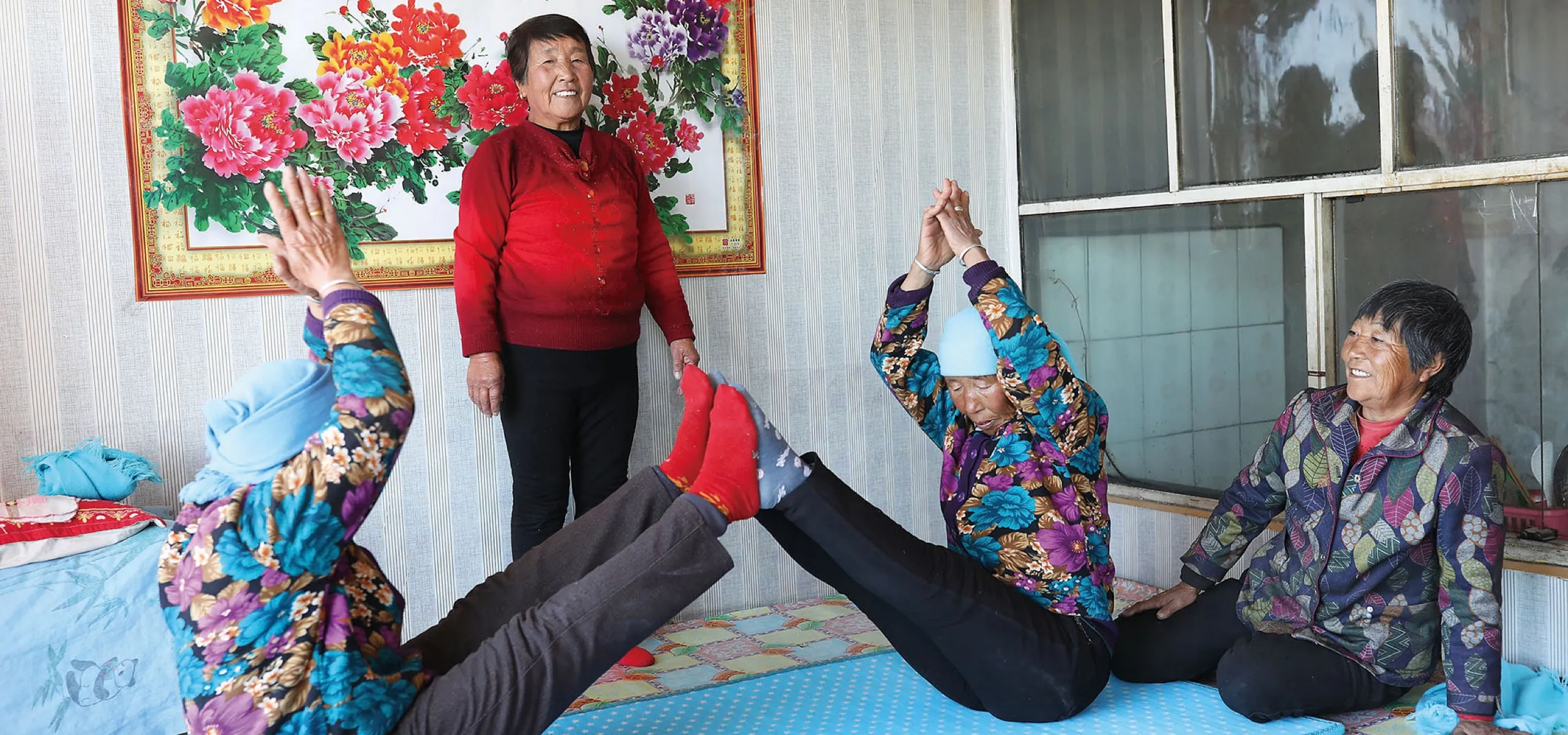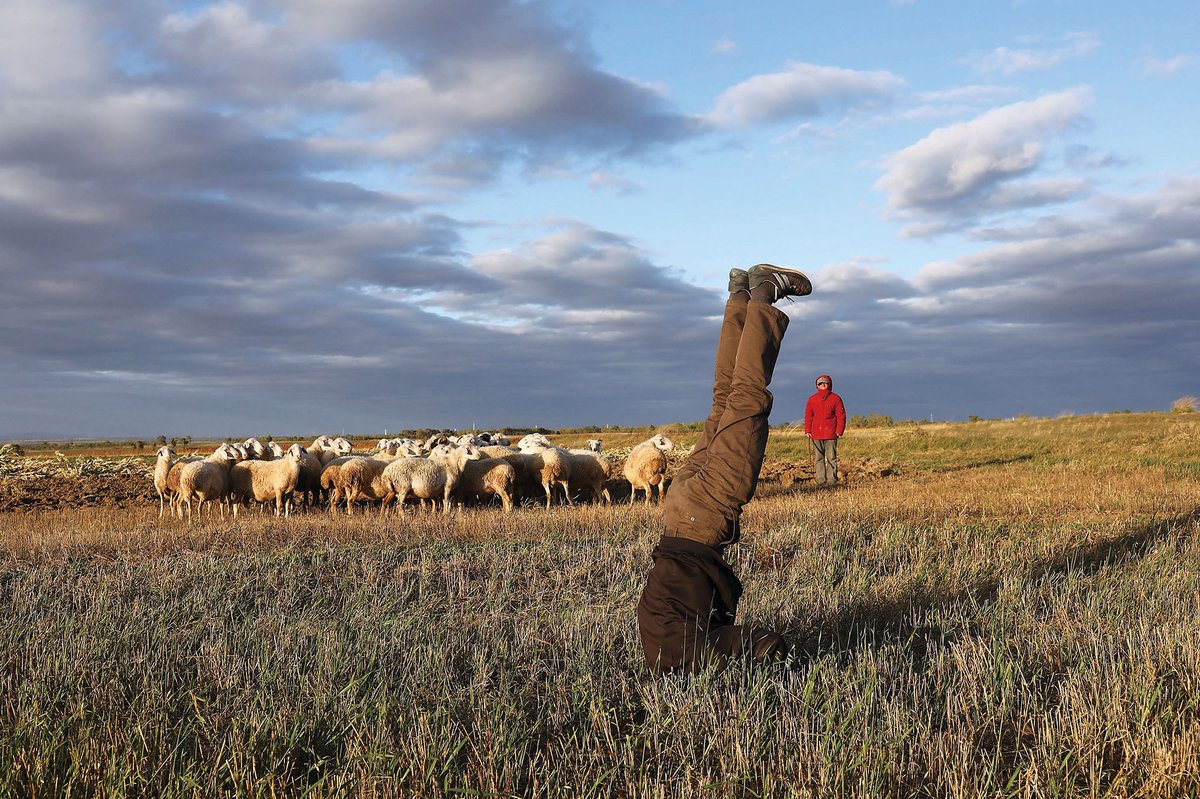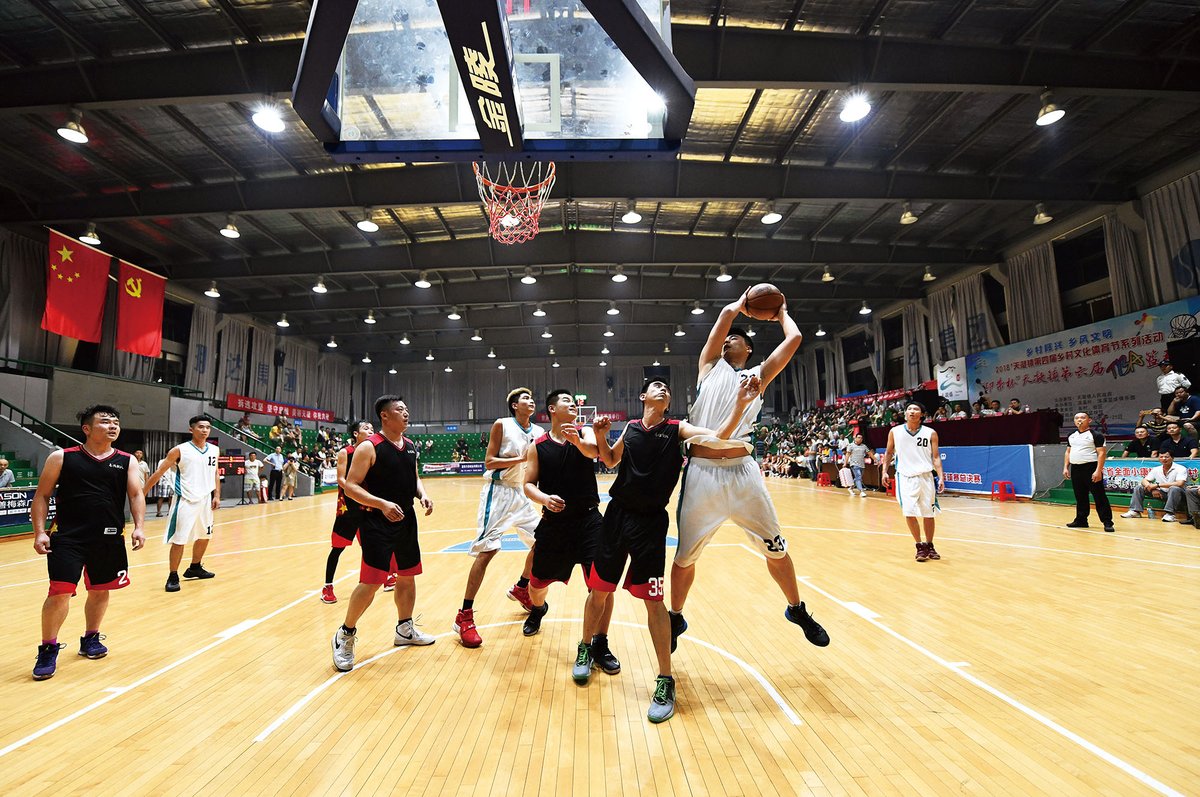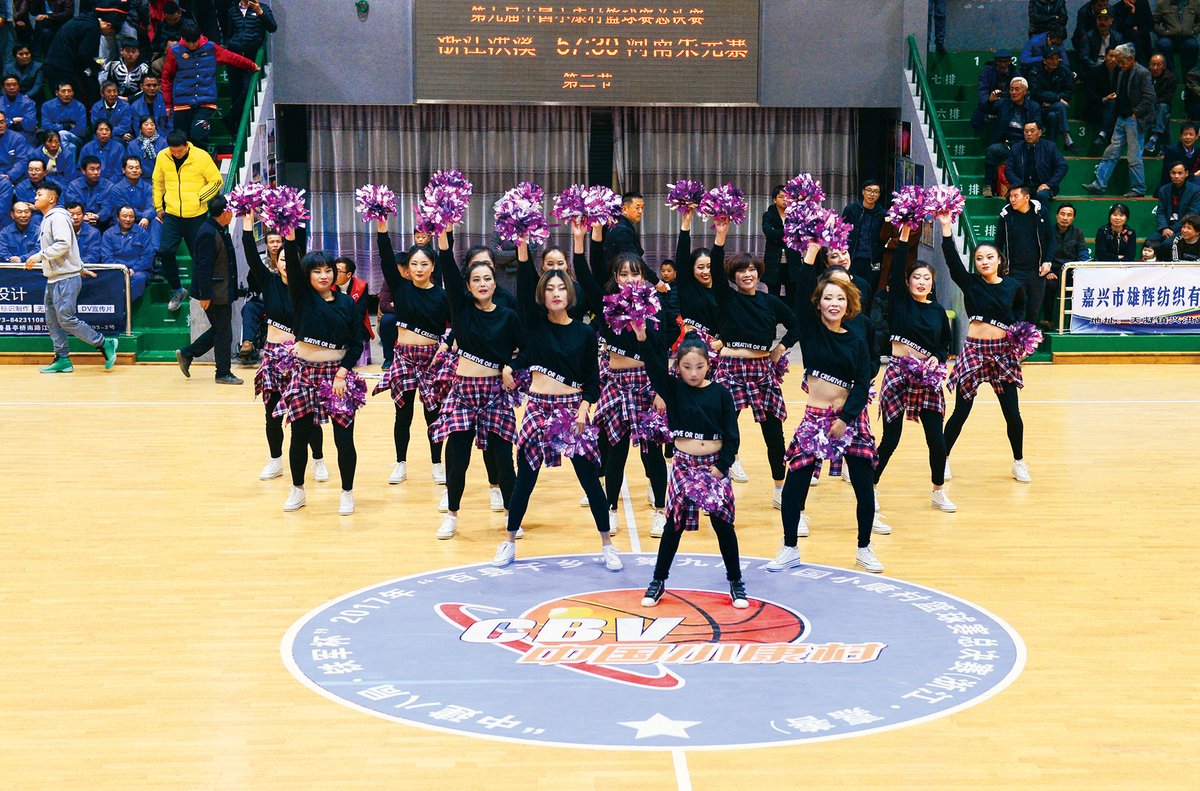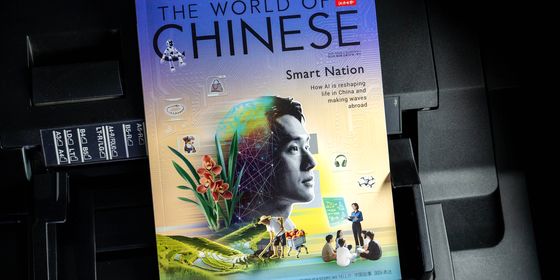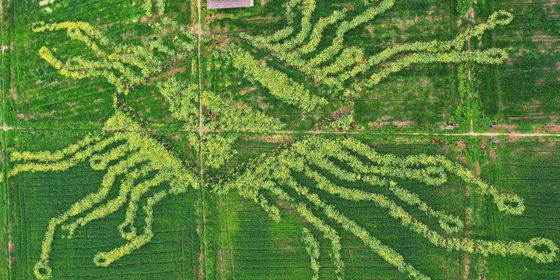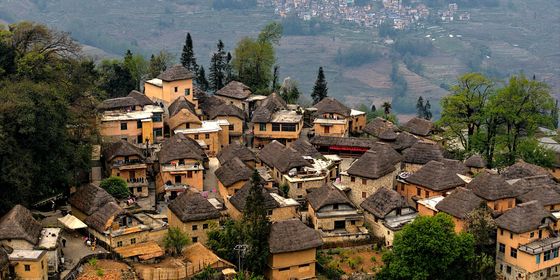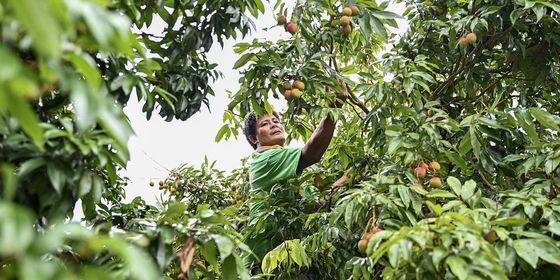Village sports programs try to get all people in China exercising—with mixed results
The village auditorium in Hongxi, Zhejiang province, was packed for the fourth night in a row. While the athlete’s sneakers screeched against the waxed wooden floor, the audience, many of them elderly farmers, tracked the movement of the ball with knitted brows and mouths agape.
At intermissions, a group of middle-aged women in fluffy green dresses marched onto the court, dazzling the audience as they swirled in circles with purple fans raised in their hands. This was Hongxi’s own grassroots cheerleading team, the “Hot Mama Babies.” On that night of November 23, 2018, Hongxi beat Shanghai’s Fumin village with a score of 74 – 73, winning the 11th China Basketball Village Championship by a hair.
“Every time we play, our villagers always shout in unison, ‘Go, Hongxi Village! Go, Hongxi Village!’” Chen Liqin, the village’s party secretary, reminisces fondly as she talks to TWOC over the phone. Organized by the Ministry of Agriculture and Rural Affairs, the China Basketball Village Championship is a series of competitions between village basketball teams from all over the country. It was the fifth time Hongxi hosted had the match. “Activities like this put the hearts of the whole village in the same place,” declares Chen.
In China’s urban areas, the sports industry is booming: According to a study of 18 cities by consulting firm Deloitte between 2019 and 2020, the annual revenue from the gym industry in these cities is now close to the total annual gym revenue of the UK, exceeding 30 billion yuan. Vancouver-based athleisure brand Lululemon doubled its revenue in China during the third quarter of 2020.
In villages like Hongxi, however, sports development isn’t measured by gym memberships and consumer spending on yoga pants. Since the early years of the PRC, China has deployed sports as an instrument to solve social problems beyond mental and physical health, and even now fitness is deeply intertwined with pressing national issues like poverty alleviation, rural depopulation, and economic development.
Besides Hongxi, the remote village of Yugouliang in northwestern Hebei province, about 100 kilometers from China’s Winter Olympic facilities in Chongli, has recently gone viral due to a group of elderly women who can strike yoga poses with apparent ease. In videos on short-video platform Kuaishou, Yugouliang’s yoga grannies, wearing their signature blue head wraps, practice full lotus sits, snap into headstands, and even bind their legs behind their heads in fields, the snow, and on concrete sidewalks. Behind them, there’s often a white wall scrawled with a slogan in big red characters: “Poverty alleviation gathers the wisdom and hearts of the people. Yoga practice brings out the spirit of Yugou.”
For Yugouliang, yoga does not only bring out spirit, but also fame—the village has now been heavily covered by domestic and international media outlets, featured in a film, and anointed “China’s first yoga village” by the General Administration of Sports (GAS).
The village shares the struggles of many rural locations in China: remote, with scarce precipitation and land productivity, suffering from an exodus of young labor, and left with roughly 100 residents, 80 percent of whom are above age 65. The forces of these challenges were evident in the ailing population, when Lu Wenzhen arrived in 2016 to serve as the village’s party secretary.
Since 2012, when the Chinese government made it a priority to eradicate poverty nationwide, Beijing has sent 3 million cadres to impoverished rural areas to establish and carry out targeted poverty alleviation strategies. Impressed by the way locals sit cross legged on their beds for long periods of time, Lu decided that yoga training could help the village become more prosperous. His logic was straightforward: Villagers already seemed to have the flexibility, and if this sport could strengthen their body and spirit, it might also reduce their medical bills.
Stories of sporting villages tick many boxes of China’s development goals. Besides eradicating poverty and caring for its aging population—70 percent of rural elders suffer from chronic disease according to the 2014 China Longitudinal Aging Social Survey, a nationwide survey led by Renmin University—and increasing positive coverage about China in the media, fitness and sports have also become part of the national agenda.
The State Council’s “Healthy China Initiative 2030,” first announced in 2016, set a goal of getting 40 percent of the population exercising “regularly” by 2030, defined as at least 30 minutes of mid-to-high-intensity workouts more than three times a week. It also called for sports facilities in all villages nationwide, which include “at least one standard concrete basketball court and two table tennis stations,” stated Lang Wei, then-head of the Sport for All Department at GAS, at a press conference in 2019.
This is not the first time that sports in rural regions made their way into China’s centralized planning. In a 2011 article, Lu Wenyun, a scholar in physical education at China West Normal University, and Ian Paul Henry of Loughborough University in the UK, comb through Chinese rural sports policies from 1949 to 2008, and group the developments into three stages.
The first began with the establishment of the PRC in 1949 and ends after the Cultural Revolution in 1977, and was marked by the theme of “improving fitness for labor and national defense.” For the growing new nation with a majority rural population, building up a national defense and healthy workforce was a priority. It was during this period that “radio gymnastics” workouts, a system of non-intensive calisthenics, became popularized in schools and state enterprises.
As China’s focus shifted from national defense and class struggle to economic development, Lu and Henry mark 1977 to 2001 as the second stage of rural sports policies, focused on incorporating sports in education and using it to enrich lives and “improve people’s moral well-being.” In 1985, the central government started a rewards system for “advanced sports counties” based on the size of their sports budget, participation, and organizational structures, and it began to hold a national sports competition for farmers every four years starting in 1988.
A dedicated governmental department, the National Sports Federation for Farmers, was established in 1986 to oversee the implementation of sports policy in rural areas and channel funding into rural sports, such as through the 2001 Xuetan Project, which allocated funds raised by the national sports lottery tickets to construction of sports venues and facilities in remote and impoverished areas.
The third period, from 2001 to the Beijing Olympics in 2008, is considered a period of equity and inclusion by Lu and Henry, which saw increased government investment to strengthen sports organization and facilities, especially in poverty-stricken areas, as a way of bridging the urban-rural gap.
Throughout these shifts, sports have been viewed as an instrument that plays various roles beyond just improving physical and mental health. At the grassroots, the role of sports in rural development also varies. Yugouliang, for example, looks to expand poverty alleviation beyond merely skimming medical costs. Capitalizing on its yoga fame, the village has been testing the waters of developing into a tourist destination, or harvesting its newfound social media influencer status to sell locally-grown quinoa or selenium-enriched potatoes.
In some villages, sports are a social adhesive. Hongxi village had been going through some rough patches in the early 2000s, when grudges brewed between residents and the village administration over the government’s handling of land requisitions. According to Chen, it was only during the occasional basketball games against other villages, a local tradition that has waxed and waned since the 1940s, that residents manifested some unity in cheering for Hongxi.
Chen, therefore, saw reviving the village basketball team as a way to occupy the time of villagers who might otherwise be petitioning the local government or fighting among themselves for land rights, as well as to foster closeness between residents and local officials by getting them to play together. For middle-aged women who didn’t play basketball, Chen got them together to form the cheerleading team.
“It was a bit embarrassing at first,” Chen admits. Then in her 40s, and describing herself as “not having a single artistic gene,” she signed herself up for the team going door-to-door to convince other women to join. The Hot Mama Babies now has 26 members with an average age of 43, who are frequently invited to sports matches and talent shows around the country, and even attended the Ronda International Folk Gala in Spain.
The basketball team, a two-time winner in the national China Basketball Village Championship, has also managed to attract some young blood back into the aging village. Chen Jiajie, a 1.98-meter-tall 27-year-old, who trained with the provincial basketball team in Zhejiang since age 15 and was once on track to become a professional athlete, decided to return to Hongxi after he graduated from Zhejiang Normal University in 2017.
“I came back because of my love for basketball and for my hometown,” Chen Jiajie tells TWOC. He now serves as a key player on the village basketball team as well as vice-party secretary of the village, handling on-the-ground affairs from conflict resolution to pandemic control.
For other youngsters, sports are a way out of a village. In the 2020 documentary Tough Out, a baseball training institute on the outskirts of Beijing gathers teenagers from impoverished backgrounds around the country and trains them to compete internationally. Xu Huijing, the film’s director, writes in a comment on film-rating website Douban, “Baseball has given [these teens] a direction to work hard toward, and opportunities to change their destiny.”
However, promoting sports in rural areas remains a major challenge as physical education is undervalued in China’s exam-based education system, particularly in rural areas where families place more emphasis on standardized testing. In late 2015, UNICEF ran a PE teacher-training workshop in Beijing with FC Barcelona and China’s Ministry of Education, as part of a program aimed at improving physical education in rural schools in China’s underdeveloped western region, and published a report noting that “PE classes always give way to other subjects due to the heavy study load, and it’s difficult for PE teachers to get promoted.”
The report also quotes a Yusufu Maimaitiniyazi, a rural PE teacher from Xinjiang, pointing out the lack of PE facilities in developing regions. “Children in our place, both girls and boys, love soccer…Every night, we spray water on the ground so the earth hardens and children can play soccer the next day.”
According to Lang Wei, 570,000 villages had sports facilities as of 2019, slightly over 50,000 villages away from GAS’s goal of 100 percent coverage. Hongxi village invested 1.8 million yuan into renovating its basketball court in 2013, which is still well-used.
Residents in other villages, however, have complained about basketball courts being turned into parking lots or trash piles. Sometimes conflicting policies are to blame: In Xilong village in Guangdong province, a basketball court was suddenly turned into a sweet potato field in 2021, as local officials scrambled to answer the call from the Ministry of Land and Resources to restore farmlands.
Even when facilities are built, lack of awareness often keeps villagers from incorporating sports into their daily lives. A survey across eight provinces run by scholars of Peking University and Beijing Normal University published in 2020 found that “22.03 percent (764) of the sampled households did not know that their villages had public sports facilities, while 33.42 percent (1,159) of them did not know about the public sports activities organized by their villages.”
Some suggest sports are unnecessary. “In our village, people don’t really have a concept of sports, but they are not just sitting around,” observes Wu Wenjie, a resident of Peitian village in Fujian province in his 20s, who has returned to the village after graduation from university to run education and cultural heritage initiatives.
He shares with TWOC that even though the village has not organized sports-related activities, villagers get their share of physical activity by taking walks, fishing, or climbing the mountains nearby to forage for wild fruits, herbs, or bamboo shoots. “Only city dwellers feel the need to find time to do sports. For us in rural areas, most of our day-to-day job is already exercising.”
Taking the Field: Bringing Sports to Every Village is a story from our issue, “Sports for All.” To read the entire issue, become a subscriber and receive the full magazine.





